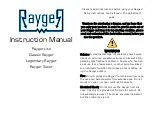
15
Cytotoxic Lead Shielded Class II Biological Safety Cabinets
Chapter 4 – Working in the Cabinet
This chapter provides some suggestion on working in the Cabinet. If used, these procedures complement the
basic instruction provided in Chapter 3.
4.1
Preparation Steps
1.
Wash hands thoroughly using germicidal soap. Wear adequate personal protection equipment
(gloves, lab. gown, etc).
2.
Adjust the seating height and position for optimal operator comfort.
3.
Fully open the sash window. Thoroughly surface-decontaminate the work area.
4.
Surface-decontaminate all apparatus/items before loading them into the work zone.
5.
Arrange the materials/ apparatus in a way that the movement of contaminated items over the clean
ones is minimized. Segregating the clean items from the contaminated ones in this way provides very
good protection from cross-contamination.
6.
Adjust the sash to its normal operating height and allow the blower to run for another 3 minutes in
order to purge work zone of contaminants.
4.2 Working in the Cabinet
1.
As far as possible, start working from the side of the Cabinet where clean items/apparatus have been
arranged and then move towards the sides where the contaminated/hazardous ones have been
arranged. Such a practice would complement the technique of segregation of clean and dirty
items/apparatus inside the Cabinet. Work with one specimen at a time and recap each specimen
before moving to the next one.
2.
Hold open tubes and bottles as vertically as possible to avoid spillage. Discard empty tubes and
bottles into collection bags placed inside the Cabinet immediately after use.
3.
Use convenient pipetting aids. Do not mouth-pipette. Use horizontal pipette discard pans containing
some suitable disinfectant inside the Cabinet.
4.
Hold lids/covers over dishes/sample plates in order to prevent the downward air from impinging on
the samples.
5.
If streaking loops are to be sterilized to prevent cross-contamination of biological materials, an
electrical in incinerator is recommended.
6.
Surface-decontaminate before removing any potentially contaminated items from inside the Cabinet.
7.
If a vacuum line is present, protect the building vacuum system from biohazards by placing a cartridge
filter between the vacuum trap and the source valve in the Cabinet.
4.3 Ending Steps
1.
Surface-decontaminate all the items/apparatus before removing them from the Cabinet. It is
recommended that the fan be left ON during this period.
2.
Thoroughly surface-decontaminate the work surface, side walls, inner back wall and drain pan.
Periodically clean behind the sash window too.
3.
Leave the blower on for 3 minutes in order to purge airborne contamination from the work zone.
4.
Remove the gloves first and then any laboratory garbing and thoroughly wash your hands using
antimicrobial soap.
The procedure provided in this chapter is by no means complete and not meant to substitute the SOP established by the
laboratory/company –
always refer to the laboratory/company standard operating protocol whenever possible.
Summary of Contents for Cytoculture LS2-4A1
Page 7: ...Cytotoxic Lead Shielded Class II Biological Safety Cabinets v...
Page 9: ...Cytotoxic Lead Shielded Class II Biological Safety Cabinets vii...
Page 17: ...8...
Page 23: ...14...
Page 27: ...18...
Page 28: ...APPENDIX...
Page 29: ......
Page 31: ......








































